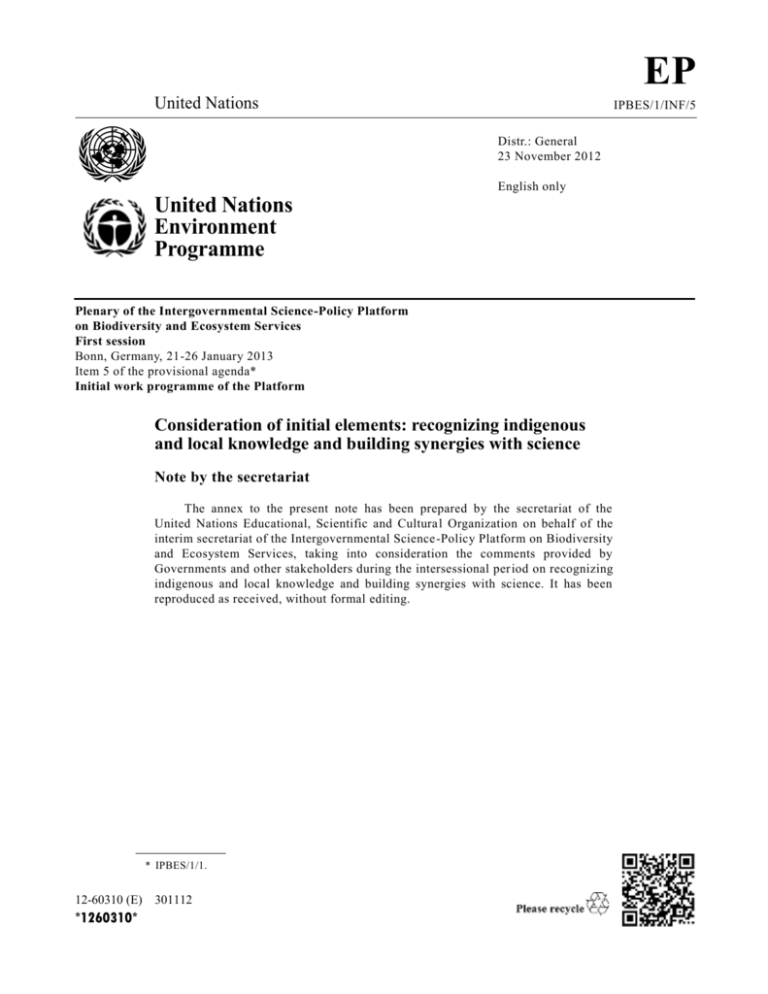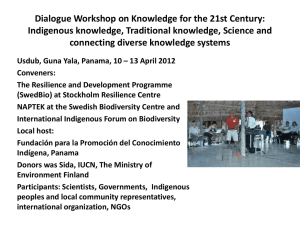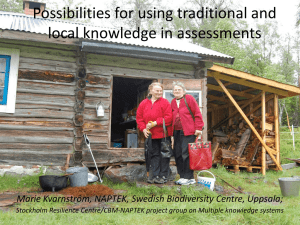Etpu - IPBES
advertisement

EP United Nations IPBES/1/INF/5 Distr.: General 23 November 2012 English only United Nations Environment Programme Plenary of the Intergovernmental Science-Policy Platform on Biodiversity and Ecosystem Services First session Bonn, Germany, 21-26 January 2013 Item 5 of the provisional agenda* Initial work programme of the Platform Consideration of initial elements: recognizing indigenous and local knowledge and building synergies with science Note by the secretariat The annex to the present note has been prepared by the secretariat of the United Nations Educational, Scientific and Cultural Organization on behalf of the interim secretariat of the Intergovernmental Science -Policy Platform on Biodiversity and Ecosystem Services, taking into consideration the comments provided by Governments and other stakeholders during the intersessional per iod on recognizing indigenous and local knowledge and building synergies with science. It has been reproduced as received, without formal editing. * IPBES/1/1. 12-60310 (E) 301112 *1260310* IPBES/1/INF/5 Annex Consideration of initial elements: recognizing indigenous and local knowledge and building synergies with science The present document highlights some of the issues that need to be addressed in developing the procedures for recognizing indigenous and local knowledge and for building synergies with science to achieve the objectives of IPBES. These is sues are briefly outlined below in order to inform discussions and decisions for consideration by the plenary on a possible process to further develop the procedures on recognizing indigenous and local knowledge and building synergies with science. By bringing together knowledge from science with knowledge from indigenous peoples and local communities, it is expected that IPBES will make a novel and noteworthy contribution to global scientific assessments. The procedures for recognition of and engagement with indigenous and local knowledge are to be developed for inclusion as an annex in the Procedures for the preparation, review, acceptance, adoption, approval and publication of assessment reports and other IPBES deliverables (IPBES/1/INF/3). These procedures will guide implementation of the work programme, and respond to decisions of the IPBES Plenary with respect to inter alia: 1. Functions, operating principles and institutional arrangements of the Platform, including to ‘[r]ecognize and respect the contribution of indigenous and local knowledge to the conservation and sustainable use of biodiversity and ecosystems’ (UNEP/IPBES.MI/2/9 Appendix 1, para. 2 (d)); 2. Scientific and technical functions of the Multidisciplinary Expert Panel , including ‘[e]xploring ways and means to bring different knowledge systems, including indigenous knowledge systems, into the science-policy interface’ (UNEP/IPBES.MI/2/9, Appendix 1, para. 15 (g)); and 3. The work programme, including ‘to develop an understanding of how to effectively integrate local and traditional knowledge’ as an important function of the platform (UNEP/IPBES.MI/2/9, para. 20). These procedures are expected to contribute to meeting the objectives of the IPBES work programme, including for use across the process of preparing, reviewing, accepting, adopting, approving and publishing assessment reports and other IPBES deliverables, as outlined in IPBES/1/INF/3. There are several aspects that may need to be taken into consideration when engaging with indigenous and local knowledge systems and indigenous peoples. These include, among others, ethics, equity, the building of trust, social relationships, recognition and respect for differing epistemologies, appropriate methodologies and approaches to validation, intellectual property, access and benefit-sharing. Over the last several decades, indigenous and local knowledge has been an active area of research, and a substantial body of literature exists, both peer reviewed and gray. A number of international instruments (conventions, declarations, protocols, etc.) that make reference to diverse knowledge systems have been adopted and others are under discussion. Most importantly, indigenous peoples and local communities continue to transmit, adapt and expand thei r indigenous and local knowledge of relevance to the conservation and sustainable use of biodiversity 2 12-60310 IPBES/1/INF/5 and ecosystem services, and many have been and continue to be engaged in processes of assessment at local, subnational, national and global levels. A. A Working Definition for Indigenous and Local Knowledge Indigenous and local knowledge refers to the multi-faceted arrays of knowledge, know-how, practices and representations that guide societies in their innumerable interactions with their natural surroundings. This interplay between people and place has given rise to a diversity of knowledge systems that are at once empirical and symbolic, pragmatic and intellectual, and traditional and adaptive. There are a number of different definitions, but that of Berkes 1 cited and may serve as a working definition: a cumulative body practice and belief, evolving by adaptive processes and handed generations by cultural transmission, about the relationship of (including humans) with one another and with their environment. (2012) is often of knowledge, down through living bein gs Furthermore, several different terms are utilized: indigenous, local or traditional knowledge, traditional ecological/environmental knowledge (TEK), farmers’ or fishers’ knowledge, ethnoscience, indigenous science, folk science, among others. While each of these terms may have somewhat different connotations and reference groups, they share sufficient meaning to be used interchangeably in the present document. B. Principles of Relevance to Indigenous and Local Knowledge In developing appropriate procedures for the recognition of and interactions with indigenous and local knowledge, there are a number of international obligations that should be taken into account including inter alia: (a) Convention No. 169 on Indigenous and Tribal Peoples (ILO 1989); (b) Convention on Biological Diversity (UNEP 1992); (c) Convention for the Safeguarding of the Intangible Cultural Heritage (UNESCO 2003); (d) Convention on the Protection and Promotion of the Diversity of Cultural Expressions (UNESCO 2005); C. (e) Universal Declaration on Cultural Diversity (UNESCO 2001); (f) Universal Declaration on Bioethics and Human Rights (UNESCO 2005); (g) United Nations Declaration on the Rights of Indigenous Pe oples (2007). Protocols of Relevance to Indigenous and Local Knowledge In developing appropriate procedures for the recognition of and interactions with indigenous and local knowledge, a number of international protocols exist that __________________ 1 12-60310 Berkes, F. 2012. Sacred Ecology, Third Edition, New York, Routledge. 3 IPBES/1/INF/5 provide guidance on working with indigenous and local knowledge and indigenous peoples that might be applied in the context of IPBES, including inter alia: (a) Akwé: Kon Guidelines for the Conduct of Cultural, Environmental and Social Impact Assessments regarding developments proposed to take place or which are likely to impact on sacred sites and on lands and waters traditionally occupied or used by indigenous and local communities (Convention on Biological Diversity 2004); (b) Tkarihwaié:ri Code of Ethical Conduct to Ensure Respect for the Cultural and Intellectual Heritage of Indigenous and Local Communities Relevant to the Conservation and Sustainable Use of Biological Diversity (Convention on Biological Diversity 2010); (c) Nagoya Protocol on Access to Genetic Resources and the Fair and Equitable Sharing of Benefits Arising from their Utilization to the Convention on Biological Diversity (Convention on Biological Diversity 2010); (d) Protocols and guidelines developed by the scientific community to guide engagements of the research community with indigenous and local knowledge holders; (e) Protocols and guidelines developed at the community level 2 provide frameworks to be observed by external stakeholders when engaging with communities. These protocols may articulate customary laws, traditional structures and local values; reference international and national obligations; and set out community priorities and concerns. D. Sources of Indigenous and Local Knowledge Indigenous and local knowledge relevant for the assessment of biodiversity and ecosystem services, including for their conservation and sustainable use, are developed and maintained by indigenous peoples and local communities. This knowledge may be available to IPBES assessments from various sources and in various forms. The nature and content of knowledge may vary from one cultural group to the next, as well as within groups. Certain elements of knowledge may be largely shared, while others may be the domain of “specialists” (e.g., healers, spiritual leaders, Elders, experienced hunters or fishers, etc). Knowledge is also often gendered, and thus men and women’s knowledge may differ and be complementary. Access to certain knowledge may be limited to the initiated, restricted by age group, and may be the privileged possession of certain clans or social groups to the exclusion of others. In many indigenous societies, knowledge of biodiversity is actively sought after, updated, and exchanged on a day-to-day basis. While indigenous and local knowledge may be physically recorded in various ways by knowledge holders, it is often rooted in collective memory and transmitted orally between and within generations. It is also embodied in practice and transmitted through action. Practices with important implications for the conservation and sustainable use of biodiversity and ecosystem services are multifold, including, for example, customary resource __________________ 2 4 A non-exhaustive list of community protocols may be found at: http://www.communityprotocols.org/ and http://www.unep.org/communityprotocols/index.asp . 12-60310 IPBES/1/INF/5 management such as no-take zones governed by taboos, landscape transformation through traditional firestick management or selective plant or animal breeding to enhance domestic diversity. Indigenous and local knowledge has also been recorded and interpreted for communication and understanding outside the cultural group of origin by anthropologists, ethnoscientists, resource managers, and increasingly by the knowledge holders themselves. These efforts at cross-cultural communication also serve as sources for IPBES and may include published scientific books and articles, including peer-reviewed or gray literature, film/videos, audio recordings, maps including community maps, digital archives and databases, and collections from community museums and cultural centres. Further work and analyses may be required to better understand the scope and diversity of indigenous and local knowledge sources, and to comprehend their relevance and accessibility for IPBES assessments and other deliverables. E. Approaches and Methodologies Relevant for Indigenous and Local Knowledge A range of different approaches and methodologies have been developed in recent decades to document and better understand the distinct nature of indigenous and local knowledge systems and their multi-dimensional interactions with scientific knowledge. This cross-cultural area of work is profoundly interdisciplinary in that it brings together approaches and methods from the natural and social sciences, notably anthropology and ecology, as well as inherently transdisciplinary, as it bridges across diverse knowledge systems, notably between science and other systems of knowledge. A variety of methods have been elaborated for the recording and analysis of data and information from indigenous and local knowledge sources, with additional refinements in accordance with different types of knowledge holders, knowledg e types or the social and ecological systems being documented. Protocols have also been developed to guide the respectful engagement between researchers and indigenous peoples and local communities, ensuring their free, prior and informed consent, and the respectful treatment of the data collected. Today, indigenous peoples and local communities are increasingly engaged in the recording of their own knowledge using a wide variety of techniques and technologies, often with the purpose of knowledge preservation or enhanced knowledge transmission, including via formal and non-formal education systems and using information and communication technologies. But the work of IPBES reaches beyond recording and understanding indigenous and local knowledge in and of itself. IPBES assessments and other deliverables will require the bridging between knowledge systems and in particular the articulation of indigenous and local knowledge with science. One dimension of this challenge, the need to bring together qualitative and quantitative approaches, is an ongoing area of work within the sciences themselves, as part of continuing efforts to bridge between the social and natural sciences. Another fundamental challenge for the procedures to be developed in the framework of IPBES will be that of cultural relativity. While science is most often 12-60310 5 IPBES/1/INF/5 perceived as rational, objective and thus authoritative, analyses from historical, sociological, philosophical and political perspectives have made increasingly clear the cultural and social dimensions of science-based frameworks, objectives, assumptions and practices. Engagement with other knowledge systems provides an opportunity for a culturally informed appraisal of scientific knowledge and practice so as to differentiate between elements that could be recognized as “universal” or shared among knowledge systems as opposed to “relative” or unique to a specific knowledge system. Finally, increasing attention is being paid to the processes whereby new knowledge is co-produced through collaborative engagements between scientific and indigenous knowledge holders, a process that may also be of importance for global assessments of biodiversity and ecosystem services. F. Issues for Further Consideration To develop the procedures for recognizing indigenous and local knowledge and for building synergies with science within the framework of IPBES, further activities and dialogue may be required. These activities may include: (a) Scoping existing experiences, approaches and methodologies whic h bridge epistemological and institutional gaps between scientific and indigenous knowledge holders in order to identify best practices and analyse gaps; (b) Reinforcing dialogue and capacity-building between scientific and indigenous and local knowledge holders to ensure the meaningful inclusion of indigenous peoples and their expertise in the four functions of IPBES; (c) Organizing international expert workshop(s) that bring together relevant natural and social scientists with indigenous and local knowl edge holders to initiate the process of elaborating the procedures for recognizing indigenous and local knowledge and for building synergies with science within the framework of IPBES. As noted in the document on Considerations for the preparation of an i nitial work programme of IPBES (IPBES/1/2), the Plenary may wish to consider this present document when determining the potential role of the Multidisciplinary Expert Panel in the further preparation of the initial work programme. This could include the role of the Panel during the next intersessional period in overseeing further preparations on the work programme on potential activities such as recognizing indigenous and local knowledge, and making recommendations to the Plenary for consideration at its second session. 6 12-60310







